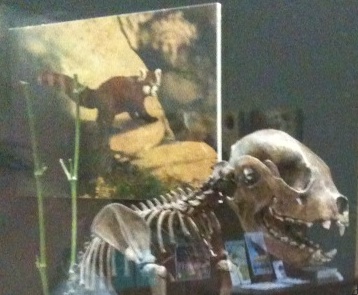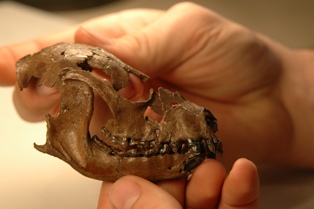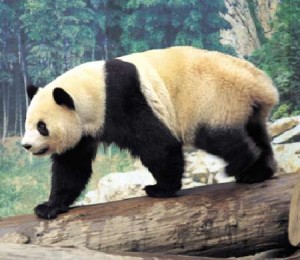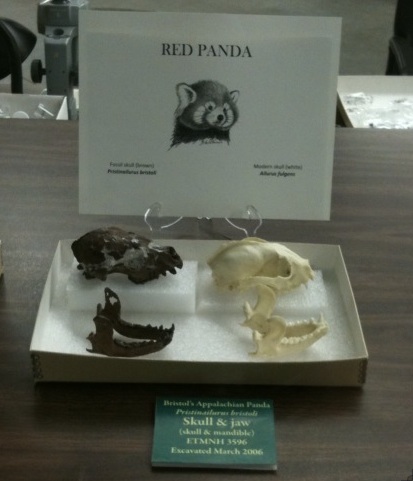
August 4, 2010

Loren Coleman photo.
New Red Panda Discovery In Tennessee!!
by Loren Coleman, International Cryptozoology Museum, Portland, Maine ©2010

When I was in Tennessee visiting my brother Jerry, during the morning of August 1, 2010, my sister Susan and I visited one of the most incredible hidden secrets in the eastern USA, the Gray Fossil Site. (I am shown above at the 2010 red panda discovery site.)
In many ways this Washington County, Tennessee museum and fossil site is the East’s version of the West’s LaBrea Tar Pits. However, whereas the mammals and other animals being found at LaBrea are of the more common Pleistocene variety, the Gray Fossil Site discoveries are mostly Miocene mammals and other species.
The Gray Fossil Site is a Late Miocene-epoch assemblage of fossils located near the unincorporated town of Gray in Washington County, northeast Tennessee, and dates from 7 to 4.5 million years BCE. The Gray Fossil Site was discovered by road crew members who found a tapir jaw in May 2000. A Tennessee Department of Transportation highway project was attempting to widen State Route 75 south of its intersection with Interstate 26. State Route 75 was realigned to protect the find by order of Tennessee Governor Don Sundquist.
The museum and research center at the dig, operated by East Tennessee State University, opened on August 31, 2007. Fossils on exhibit include a saber-toothed cat, short-faced bear, ground sloth, rhinoceros, alligator, camel, shovel-tusked elephant, Eurasian badger, tapirs, and a red panda.
New Red Panda Skull Just Discovered!
Breaking News!
While I was touring the site, including the open pits where excavating is still occurring, we were informed by guide Jan Holden that an unpublicized discovery of a new red panda skull had just been found on July 20, 2010, days before our arrival. The unique red panda species found here is the species named Pristinailurus bristoli. (Collections manager Brett Woodward, who was at the front desk, confirmed the discovery had been made while he was on vacation, but he had not been informed of all the details yet.)

New Red Panda fossil skull discovery site. Loren Coleman photo.
This is a groundbreaking and newsworthy find, and will cement the Gray Fossil Site as the location to find more surprising Miocene fossils. This will also propel the Tennessee location ahead of the previous red panda discovery location’s only find of a tooth, now here in Tennessee with an almost complete skeleton and a skull, thus two individuals, at least, being found at the Gray Fossil Site.
Red Pandas In America
Few outside paleontology realize that red pandas have been found in North America and thus demonstrate that these animals traveled over the Bering Straits to be in two New World locales.
The first red panda found in North America was located in 1977, based on an upper right first molar aged 3-4 millions (early Blancan of Pliocene) in Taunton Local Fauna of the Ringold Formation (Washington state).

Loren Coleman photo.
The fossil remains of a red panda species from the Pristinailurus bristoli species was found from 2002-2004 in Tennessee. The name of the Gray Fossil Site panda is in honor of its primary discoverer, Larry Bristol. The Gray Fossil Site now (2010) has recovered nearly 95% of the remains of that first Miocene red panda.

The red panda of Tennessee is a species close to Parailurus, a fossil red panda of Europe. Red panda fossils finds mark another fossil of an Eurasian mammal found at Gray Fossil Site. (Gray’s red panda exhibition shown above.)
A new genus and species of the red (lesser) panda (Pristinailurus bristoli), the earliest and most primitive so far known, has thus been recovered, and with this 2010 find, news is to be made there again. Also among the fauna found earlier was a new species of Eurasian badger (Arctomeles dimolodontus) and the largest concentration of fossil tapirs ever recorded.
Most zoologists place the red panda in their own family (Ailuridae). However, these fossils show a suspected close relationship between red panda and raccoons (Procyonidae family). In fact, DNA research shows a close relationship amongst red panda, raccoons and weasel family (Mustelidae).

The only living red panda (Ailurus fulgens) (see photo) is a bamboo specialized animal, slightly larger than a cat, found only in Eastern Himalaya. It is speculated at the prehistoric environment that use to be the Gray Fossil Site, the red panda ate river cane, although it has not been recovered yet.
The other much more well known panda – the giant panda – is essentially a bamboo specialized bear.

Sources:
Jan Holden, tour guide, and Brett Woodward, Collections Manager, personal communications, August 1, 2010.
R. H. Tedford & E. P. Gustafson. “First North American record of the extinct panda Parailurus” Nature 265, 621 – 623 (1977).
Steven C. Wallace & Xiaoming Wang. “Two new carnivores from an unusual late Tertiary forest biota in eastern North America” Nature 431, 556-559 (30 September 2004).

Loren Coleman photo.
This is a display of the skulls of two red panda species at the Gray, Tennessee, fossil museum. A 4.5-7 million year old fossil (Pristinailurus bristoli) on the left and a modern one (Ailurus fulgens) on the right. The major difference between the two is a ridge that runs down the top of the modern skull.
Fossils Fauna at Gray Fossil Site
Fish
Osteichthyes
Amphibians
Frogs (several taxa)
Salamanders (several taxa)
Reptiles
Alligators have recently been found at the fossil site, and they are thought to have come from a modern genus.
Snakes (several taxa including colubrids and vipers)
Turtles (four taxa including box turtles, snapping turtles, slider turtles, and painted turtles)
Mammals
Shrews (several taxa)
Moles
Small weasel
Arctomeles dimolodontus (prehistoric badger) NEW SPECIES
Pristinailurus bristoli (prehistoric Red panda) NEW SPECIES
Short-faced bears of the genus Plionarctos
Saber-toothed cats are represented by a single part of a tooth, possibly from Machairodus.
Shovel Tusked Elephants, or gomphotheres, are also present at the site. At the time it is unknown which species they belong to, but it is most likely that they belong to Amebelodon or a similar genus.
Teleoceras A species of hippo-like rhino common in other parts of the continent during the same time period, and lived a lifestyle similar to the modern-day hippopotamus. Several complete skeletons have been unearthed.
Prehistoric camel, possibly a member of the genus Megatylopus.
Tapirus polkensis (prehistoric tapir) Found in large numbers at the site, including juvenile specimens.
Peccary (undetermined taxon)
Rabbits
Rodents (several taxa)
Extinct Beaver of the genus Dipoides.
Ground Sloth (genus and species unknown)
Three-Toed Horse (genus and species unknown) (fossil list via Wikipedia)

About Loren Coleman
Loren Coleman is one of the world’s leading cryptozoologists, some say “the” leading living cryptozoologist. Certainly, he is acknowledged as the current living American researcher and writer who has most popularized cryptozoology in the late 20th and early 21st centuries.
Starting his fieldwork and investigations in 1960, after traveling and trekking extensively in pursuit of cryptozoological mysteries, Coleman began writing to share his experiences in 1969. An honorary member of Ivan T. Sanderson’s Society for the Investigation of the Unexplained in the 1970s, Coleman has been bestowed with similar honorary memberships of the North Idaho College Cryptozoology Club in 1983, and in subsequent years, that of the British Columbia Scientific Cryptozoology Club, CryptoSafari International, and other international organizations. He was also a Life Member and Benefactor of the International Society of Cryptozoology (now-defunct).
Loren Coleman’s daily blog, as a member of the Cryptomundo Team, served as an ongoing avenue of communication for the ever-growing body of cryptozoo news from 2005 through 2013. He returned as an infrequent contributor beginning Halloween week of 2015.
Coleman is the founder in 2003, and current director of the International Cryptozoology Museum in Portland, Maine.
Filed under Breaking News, Cryptomundo Exclusive, Cryptotourism, CryptoZoo News, Extinct, Fossil Finds, Living Fossils, Museums, New Species